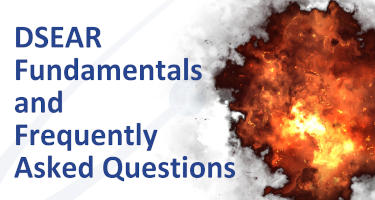What do Dangerous Substances and Explosive Atmospheres Regulations apply to?
DSEAR apply to a range of scenarios where hazardous substances are present that might pose risks to safety from fire, explosion, or other energy-releasing events. These regulations apply primarily in the workplace in the UK and include the following areas: Workplaces and Work Activities: DSEAR covers any workplace where dangerous substances are present, including industrial settings like factories, refineries, and warehouses, as well as commercial environments like garages or labs.
Processes and Uses of Dangerous Substances: Any process that uses or produces dangerous substances, such as chemical manufacturing, spray painting, or handling flammable materials, falls under DSEAR.
Storage and Transport of Dangerous Substances: Regulations include requirements for safely storing and handling dangerous substances to prevent leaks, spills, and other accidental releases.
Installation, Maintenance, and Use of Equipment: Equipment that contains or uses dangerous substances must be properly designed, built, maintained, and used to minimise risks.
Workplace and Plant Design and Operation: The layout and operational procedures of workplaces must consider the presence of dangerous substances to ensure safety.
Protection Against Corrosive Substances: While primarily focused on explosive and flammable hazards, DSEAR also covers environments where corrosive substances can cause hazardous atmospheres.
What is a Hazardous Area as defined by DSEAR?
Hazardous areas are classified based on the likelihood and persistence of an explosive atmosphere. The classification of areas where explosive atmospheres may occur uses the following zones:
Zone 0, 1, and 2 for Gases, Vapours, and Mists:
Zone 0: An area in which an explosive gas atmosphere is present continuously or for long periods.
Zone 1: An area in which an explosive gas atmosphere is likely to occur in normal operation.
Zone 2: An area in which an explosive gas atmosphere is not likely to occur in normal operation and, if it occurs, will exist only for a short time.
Zone 20, 21, and 22 for Dusts:
Zone 20: An area in which an explosive atmosphere in the form of a cloud of combustible dust in air is present continuously, or for long periods or frequently.
Zone 21: An area in which an explosive atmosphere in the form of a cloud of combustible dust in air is likely to occur in normal operation occasionally.
Zone 22: An area in which an explosive atmosphere in the form of a cloud of combustible dust in air is not likely to occur in normal operation but, if it does occur, will persist for a short period only.
Safety Measures in Hazardous Areas:
In areas designated as hazardous area zones, employers are required to implement special safety measures including: Control Measures: To prevent the formation of explosive atmospheres and limit the spread of fires.
Mitigation Measures: To limit the damaging effects of an explosive event should it occur.
Signage and Marking: Clear marking of hazardous zones and informing about the nature of the hazards.
Equipment and Protective Systems: Using equipment and protective systems that meet appropriate standards for safety in explosive atmospheres.
Training and Procedures: Ensuring that workers are trained in the risks associated with explosive atmospheres and know how to operate safely.
The identification and classification of hazardous areas are crucial for ensuring workplace safety where dangerous substances are handled or stored.
What is the best practice of DSEAR?
Best practices for complying with the Dangerous Substances and Explosive Atmospheres Regulations (DSEAR) include conducting thorough risk assessments to identify and manage risks associated with dangerous substances. Key strategies involve:
Identification and Classification: Clearly identifying hazardous areas and classifying them according to the risks of explosive atmospheres.
Risk Reduction Measures: Implementing control measures to prevent the formation of dangerous atmospheres and to limit the effects of any incidents.
Equipment and Safety Systems: Using appropriate, well-maintained safety and protective equipment designed to operate safely in hazardous conditions.
Information and Training: Ensuring all personnel are informed and trained about the risks and the precautions necessary to work safely.
Emergency Procedures: Establishing and practicing effective emergency procedures to be followed in case of an incident involving dangerous substances.
These practices help create a safer workplace by minimizing the likelihood of explosive or toxic incidents and enhancing overall safety management.
Is ignorance of DSEAR enough to be an excuse?
In the context of DSEAR, the principle that "ignorance of the law is no excuse" is particularly important. This legal doctrine, known as "ignorantia juris non excusat," means that individuals and organizations cannot avoid responsibility for violating laws just because they were unaware of them.
For DSEAR, this underscores the necessity for employers and operators to actively educate themselves about the regulations and implement the necessary safety measures. Failing to comply can lead to significant legal and financial consequences, irrespective of whether the non-compliance was intentional or due to ignorance. This approach ensures that safety standards are maintained to protect workers and the public from the risks of explosive atmospheres and dangerous substances.
DSEAR advisory
At EPIT Group, we support organisations across multiple industry sectors s with specialised consultancy services in hazardous area classification to ensure compliance with DSEAR.
Our experts assist in determining the applicability of DSEAR to organisations’ operations and guide them in achieving compliance. That includes DSEAR surveys, risk assessments, and verification of hazardous areas, ensuring that businesses can effectively manage risks associated with dangerous substances and explosive atmospheres.
Our consultancy support includes advice on zoning classifications within a workplace, helping to determine appropriate zones for safe installation and use of equipment in areas where flammable or explosive atmospheres could occur. We provide detailed assessments and documentation, which include drawings and calculations, to support effective safety measures and equipment selection in these environments.
While we advocate industry best practices and process standardisation, we don’t just follow a cookie cutter approach: our qualified engineers provide solutions tailed to the specific needs of our clients, focusing on cost-effective and safety-oriented outcomes.
How often should DSEAR assessment be carried out?
DSEAR assessments should be conducted regularly to ensure ongoing compliance and safety. It’s recommended that they are carried out at least every five years. However, the frequency of these assessments can depend on several factors, including:
Changes in Processes or Substances: If there are any changes in the work processes, materials used, or the volume of dangerous substances handled, a reassessment is necessary to evaluate new risks.
Incidents or Near Misses: Any incidents or near misses involving explosive atmospheres or dangerous substances should trigger an immediate reassessment to prevent future occurrences.
Legal Requirements: While there is no set frequency mandated by law, it is generally advisable to review DSEAR risk assessments at least annually to ensure that all measures are up to date and effective.
Technological or Legislative Changes: Updates in safety technology or changes in safety regulations may also necessitate a reassessment.
Overall, the key is to ensure that the risk assessment is current and reflective of all changes and developments in the workplace environment. Regular reviews and updates help in maintaining a safe work environment, aligning with best safety practices and compliance requirements.


